New Order Architecture: Exploring the Future of Design

In today’s ever-evolving world, the realm of architecture has seen a remarkable shift towards a new order of design. This cutting-edge approach, aptly named ”New Order Architecture,” represents a paradigm shift in how buildings are envisioned and constructed. In this article, we delve into the depths of this architectural revolution, providing an in-depth overview, thorough presentation, quantitative measurements, and a discussion of the nuances that set various New Order Architecture styles apart. Additionally, we explore the historical journey of this innovative design philosophy, weighing its advantages against its challenges.
A Comprehensive Overview of New Order Architecture
New Order Architecture, a term coined in recent years, showcases a futuristic and forward-thinking design ethos that challenges conventional architectural norms. This movement embraces technology, sustainability, and functionality to elevate the built environment.
Traditionally, architecture has focused on achieving harmony between form and function. However, New Order Architecture goes beyond these traditional principles, aiming to create a seamless integration of human interactions, natural systems, and advanced technologies. It pushes the boundaries of creativity and innovation, creating spaces that captivate the senses and improve the overall quality of life.
The Many Facets of New Order Architecture

New Order Architecture encompasses a vast range of styles that exemplify its core principles. From minimalistic and futuristic designs to organic and biomimetic structures, each architectural style embraces the essence of New Order Architecture while offering unique characteristics.
1. Minimalistic New Order Architecture: This style emphasizes clean lines, simplicity, and functionality. It eliminates unnecessary ornamentation and focuses on creating open spaces that promote a sense of calm and clarity.
2. Futuristic New Order Architecture: As the name suggests, this style embodies a vision of the future, incorporating innovative materials, advanced technologies, and unconventional forms. It seeks to create awe-inspiring structures that are as visually striking as they are functional.
3. Organic New Order Architecture: Drawing inspiration from nature, organic New Order Architecture strives to mimic natural forms and systems. It focuses on sustainability, using eco-friendly materials and implementing energy-efficient design solutions.
4. Biomimetic New Order Architecture: This style takes the concept of organic architecture further by mimicking not only natural forms but also the underlying principles and systems of nature. It seeks to emulate nature’s efficiency and resilience through design.
Quantitative Measurements in New Order Architecture
To gauge New Order Architecture’s impact and effectiveness, quantitative measurements play a crucial role. Architects and designers utilize various metrics to evaluate key factors such as energy efficiency, natural light optimization, and carbon footprint reduction.
One widely used measurement is the Building Performance Index (BPI), which assesses buildings’ overall energy consumption and efficiency. Additionally, energy modeling software enables architects to simulate and optimize a building’s energy performance before construction, aiding in the creation of sustainable designs.
Another important metric is the daylight factor, which quantifies the amount of natural light available within a space. Maximizing natural light reduces reliance on artificial lighting and improves occupants’ well-being and productivity.
Furthermore, the Life Cycle Assessment (LCA) measures the environmental impact of a building, considering its materials, construction, operation, and eventual demolition. Architects strive to reduce a building’s carbon footprint and utilize eco-friendly materials to enhance sustainability.
Understanding the Differences in New Order Architecture
Despite the overarching principles that unite New Order Architecture, subtle differences exist within its various styles. These differences lie in the use of materials, forms, integration of technology, and overall design philosophy.
For instance, minimalistic New Order Architecture predominantly focuses on simplicity and functionality, whereas futuristic New Order Architecture explores radical forms and cutting-edge technologies. Organic and biomimetic architecture delve into sustainability and the seamless integration of natural elements.
Moreover, cultural and regional influences have a significant impact on New Order Architecture styles. Architectural designs in Asian countries may feature a harmonious blend of tradition and modernity, while European designs often prioritize sustainable materials and energy-efficient practices.
Tracing the Historical Pros and Cons of New Order Architecture
As with any architectural movement, New Order Architecture has its fair share of advantages and challenges. Understanding its historical journey can shed light on how it has evolved and adapted over time.
Advantages:
1. Enhanced Sustainability: The focus on energy efficiency, eco-friendly materials, and sustainable design practices contribute to a smaller environmental footprint.
2. Technological Integration: New Order Architecture embraces technological advancements, enabling smart and interconnected buildings that enhance functionality and user experience.
3. Improved Quality of Life: By prioritizing occupants’ well-being, New Order Architecture creates spaces that promote health, productivity, and comfort.
Challenges:
1. High Costs: Implementing cutting-edge technologies and sustainable materials can increase construction costs, posing a financial barrier to widespread adoption.
2. Aesthetics vs. Functionality: Balancing the pursuit of innovative aesthetics with practical functionality can be a complex challenge, impacting usability and maintenance.
3. Acceptance and Integration: New Order Architecture may face resistance and require adjustments within existing systems and regulations to accommodate its unconventional approaches.
In conclusion, New Order Architecture presents an exciting opportunity to reimagine the built environment, blending form, function, technology, and sustainability. This article provided a comprehensive overview of this architectural movement, exploring its various styles, quantitative measurements, differences within the styles, and a historical examination of its pros and cons. As the world evolves, New Order Architecture continues to shape the future of design, creating spaces that inspire and elevate the human experience.











